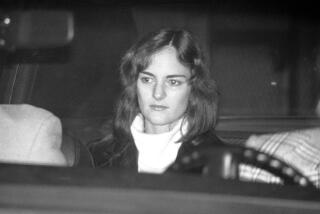Hubby Helped Earhart Fly Into History
- Share via
It was a brief union that seemed more like a Hollywood business partnership and a modern open marriage: the pairing of a publicity-seeking genius and the courageous queen of aviation.
Although Amelia Earhart’s feminist spirit and 1937 epic air journey earned her an enduring place in history as a record-breaker and as a mystery, it was her worldwide publicity campaign--the brainchild of her husband--that propelled her permanently onto the world’s stage and into its heart.
Though her name has survived and even grown in renown, the name of her husband, George Palmer Putnam--a flamboyant publishing magnate who gave up his family’s business in New York to manage his wife’s career as she flew into history--is now forgotten.
The man who married the world-famous aviator was 12 years older than she. He was the hot-tempered heir to a publishing fortune whose first wife was a crayon heiress, and whose biggest client was Charles A. Lindbergh. His genius for publicity led him to make Earhart first his client and then his wife.
New York-born Putnam, grandson of the publisher G.P. Putnam, whose clients included Edgar Allen Poe and Washington Irving, boasted that though the atmosphere in his family home was decidedly literary, he was not.
Family pressure led the adventure seeker and Harvard dropout to rebel. He enrolled at Berkeley for one term before heading to Oregon in 1909. In the rough-and-tumble town of Bend, he became mayor after the former mayor fell to his death from a brothel window during a brawl. After cleaning up the town and marrying Crayola crayon heiress Dorothy Binney, he began his own career as publisher and editor of the local newspaper and later as secretary to an Oregon governor.
Returning to New York in 1919, Putnam took over the family publishing firm. He also made news of his own, writing four popular books about his travels. He organized, promoted and found financial backing for expeditions by explorers such as Richard Byrd.
His tremendous energy and appetite for hard work vaulted him into the big league in 1927, when he made a killing after signing Lindbergh to a contract to write what became “We,” the best-selling account of his acclaimed solo flight across the Atlantic.
From there, he was commissioned to find a “Lady Lindy” to duplicate his success.
Putnam scoured the country for an all-American-looking woman, the perfect package: a beautiful, well-bred girl and fearless flier to represent American womanhood.
His search didn’t take long. In 1928, he heard through contacts of Amelia Earhart, a licensed pilot and “social worker who flies for sport” and who did indeed look like a tomboyish version of Lindbergh.
Putnam arranged for her to fly across the Atlantic like Lindbergh did. The catch was that she was not yet licensed for instrument flying, and so Putnam fudged: Earhart was not at the controls.
Instead, she crouched behind the pilot and took notes. When Earhart returned, she simply filled in more details and the book “20 Hrs., 40 Mins.” went almost instantly to press.
The public wanted its heroine, and Putnam saw to it that it had one. Newspapers headlined her flight as “A Woman’s Triumph,” while his reports to the press said that Earhart “captivated all who met her,” but it was clear she had already captivated him.
Within a year of that flight Putnam divorced his wife, the crayon heiress, and was begging Earhart to marry him. She resisted him for more than a year, but when he finally proposed marriage for a sixth time at Burbank’s Lockheed Co., the 33-year-old consented.
On the eve of their 1931 wedding, she presented Putnam with a letter:
“I shall not hold you to any medieval code of faithfulness to me, nor shall I consider myself bound to you similarly.” She asked that they “not interfere with each other’s work or play” and told him flat-out that she could not “guarantee to endure at all the confinements of even an attractive cage.”
Although some considered theirs a marriage of convenience, there were nonetheless many loving endearments in their correspondence. By all accounts, they genuinely enjoyed each other’s company.
After he had created her renown, Putnam stayed in his wife’s background, inspiring and encouraging her, answering her fan mail, handling social and flight arrangements and introducing her to a wide circle of powerful people.
He negotiated with such companies as Lucky Strike cigarettes (though she didn’t smoke), Beech-Nut gum and makers of clothes that Earhart designed, in order to underwrite the cost of her flights, while she set speed and altitude records and won some air derbies.
The home they bought in 1935, at the end of Valley Spring Lane, is still standing. It overlooks the Lakeside Golf Course in Toluca Lake where Earhart played golf. Soon, Putnam’s mother, Frances, moved in with them.
In 1937, Earhart made her second try at an around-the-world trip. Her first had ended in failure in March that year when she badly damaged her plane while taking off from Hawaii.
Then on July 2, during her second attempt, Earhart’s plane disappeared somewhere near tiny Howland Island in the Pacific. In addition to the U.S. government’s air and sea search for her, Putnam enlisted some help of his own.
He contacted his wife’s friend, the salty flier Jacqueline Cochran, in a desperate hope that her clairvoyant powers could help. Although Cochran said that Earhart and her navigator were still alive and provided a precise position for the plane wreck, no definitive evidence has ever been found.
Since then, scores of books, movies and magazine articles have explored the possibilities. Putnam, obsessed with finding her, spent months tracking down every lead and exhausted his bank account before he gave up.
He continued to promote his wife and her achievements in books and lectures, making his living that way. He completed the book she had been working on when she died, and named it “Last Flight.”
Putnam also worked on film proposals about her life. He remained in the public eye and retained public sympathy as Earhart’s widower until he tried one stunt too many, and then his unabashed ability to make news soon became his downfall.
In 1939, with Europe at war, he published a novel called “The Man Who Killed Hitler.” To boost sales, he contacted the Los Angeles district attorney’s office and reported that he had received a letter threatening his life unless he stopped publication of the book. The next day the letter appeared in the newspapers.
Three weeks later, after receiving more allegedly threatening letters, phone calls and a bullet-riddled copy of the book, lawmen somehow discovered Putnam, unharmed, bound and gagged in a half-built house in Bakersfield. He got the headlines he wanted: “Putnam Kidnapped. Anti-Hitler Book Seen as Link.”
Reporters suspected a scam, and published their suspicions. Chagrined, Putnam moved to Lone Pine and remarried, a marriage that would end in divorce.
He was in his mid-50s when he enlisted in the Army Air Corps and then spent most of World War II in the Far East as an intelligence officer. He briefed pilots for bombing missions and in his spare time checked out alleged Earhart sightings.
It was during the war that a movie about Earhart, “Flight for Freedom” starring Rosalind Russell, was released. Putnam had spent years pitching a movie about her, so he was heartbroken when the producers didn’t choose his version.
The movie planted the idea in the public’s mind that Earhart was taken prisoner on a small island in the Pacific, enabling the U.S. Navy to gather intelligence about Japanese-held islands in their search for her. It also portrayed her as madly in love with her navigator.
If any of the rumors about Earhart’s fate had turned out to be true, Putnam would never have passed up an opportunity to write about them.
After the war, he returned home in poor health, married for a fourth time, and died in California at age 63 in 1950.
More to Read
Sign up for our Book Club newsletter
Get the latest news, events and more from the Los Angeles Times Book Club, and help us get L.A. reading and talking.
You may occasionally receive promotional content from the Los Angeles Times.







